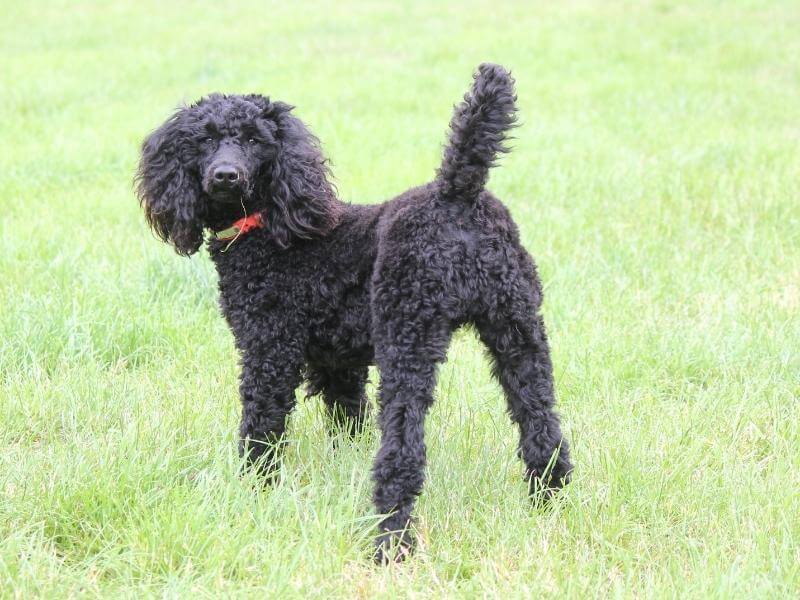Poodle mixes, or Doodles, are the world’s most famous designer dogs. There are Labradoodles, Goldendoodles, Maltipoos, Shi Poos, Cockapoos, Cavapoos, Yorkipoos, and Poochons. And one of the newest Doodles is the Leonberger-Poodle mix, the Leondoodle.
If you know anything about Leonbergers, you know they are big, friendly dogs. Poodles, on the other hand, can be petite, brilliant dogs.
So, what happens when you cross the big-hearted Leonberger with the smarty-pants Poodle? Keep reading to find out!
History of the Parent Breeds
When children draw pictures of big dogs, they often draw a dog that looks a lot like a Leonberger. When adults look for trainable, beautiful, intelligent dogs, they often think of a Poodle.
Both breeds have been around for over a century. But Leonbergers are not as well known as Poodles.
Leonberger

Leonbergers themselves started as designer dogs. Created by dog breeder Heinrich Essig in 1846 in Leonberg, a town in Germany, Leonbergers are a mixture of Great Pyrenees, Newfoundland, and Saint Bernard.
Essig aimed at creating an extremely friendly dog that was large enough to be a working dog, pulling carts. The esteemed dog breeder gave Leonbergers to the emperors of Germany and Austria-Hungary.
The breed was immediately popular in Central Europe. But because Leonbergers were not purebreds, they were ignored in Great Britain and the United States. Leonbergers caught on in the United States in the 1990s.
Personality of the Leonberger
Leonbergers are great family dogs. They are unpredictable enough to make an exciting addition to the family.
Leonbergers eat enthusiastically. This is the dog that really will eat your homework. Leonbergers have also been known to eat their beds, whole pumpkins, leather chair cushions, deck railings, pillows, and LEGO sets. They let their culinary instincts take over when they are left alone for longer than they deem appropriate.
Leonbergers seem to have some genetic knowledge of a game called spithead. They will attempt to cover a sibling’s entire head with their spit while pretending to gnaw and bite around the other dog’s head and ruff. Any actual biting is accidental.
They also seem to have an instinctive knowledge of a game called “alligators,” in which two Leonbergers lie down next to each other and open their jaws wide as if they were dueling alligators or crocodiles.

Leonbergers are excellent therapy dogs. Working alone, they have a great bedside manner with sick and lonely people. Leonberger’s eyes have a kind expression, and there is no doubt that the dog is present when a Leonberger visits a patient in a nursing home or a hospital.
Leonbergers love agility drills, activities on the water in warm weather, sledding, backpacking, and carting. They were initially bred to help older adults with transportation by pulling them around in small carts like tiny horses.
Leonbergers are poor kennel dogs. Leonbergers need to be the center of canine attention in their living space.
Poodle

The Poodle is an icon of France, but the breed was created in Germany. Poodles were bred for swimming in a Pudel and retrieving ducks that archers shot with bows and arrows. They were bred to be highly intelligent and responsive to commands.
Their wiry coats protected them in cold water, and the webbing between their toes gave them superior swimming ability. Poodles were the smaller working dogs of Germany in the sixteenth and seventeenth centuries.
Personality of the Poodle
One of the most outstanding aspects of Poodle temperament is their intelligence. Rankings of canine intelligence by breed usually put Poodles in the number-two position. Still, it might be accurate to note differences between Poodles and the “most intelligent” breed, the Border Collies.
Border Collies will learn a command quickly and repeat the action repeatedly. Poodles will learn a command quickly and put their own spin on how to accomplish it as they are given the command on different occasions.
And another of the most important aspects of Poodle temperament is their ability to pick up subtle clues of human emotions. Poodles will notice things about mood, of their owners, and of people, they encounter outside the home that sometimes even their human owners will not.
It is fundamental to a Poodle’s temperament to crave human company. Poodles that are left alone for prolonged periods of time do not do well.
Poodles must be socialized to other dogs when they are puppies to ensure they do not suffer separation anxiety and become unmanageably clingy as adults. Poodles react negatively to harsh tones of voice.
Size
It’s important to understand that Leonberger-Poodle crosses are typically between a Leonberger female and a Standard (some commentators say Giant) Poodle male.
Female Leonbergers can weigh up to 135 pounds (61 kg) and average 115 pounds (52 kg). Male Standard Poodles can weigh up to 71 pounds (32 kg) and average around 60 pounds (27 kg).
Breeding a male Leonberger to a female Standard Poodle, 120 to 170 pounds (54 to 77 kg) versus 44 to 71 (20 to 32 kg), could result in puppies that are too large for the Poodle female to bring to term. But crossing a female Standard Poodle with a male Leonberger results in an adorable, healthy, large-but-not-too-large litter of 5 to 7 Leonberger-Poodle puppies.
The challenges of pregnancy with Leondoodle puppies are why you shouldn’t try to create this designer dog on your own. Choosing the right parents to create designer dogs is, for reasons we will explain a little later, something best left to ethical, caring, professional dog breeders.
Too many things can go wrong if you just allowed this kind of interbreeding between a Leonberger and a Poodle at home.
Coat Color
Leonbergers have coats of brown, sometimes with overtones of red, yellow, and sand. The American Kennel Club recognizes all four colors. Their size and geniality draw your attention, from their coloration to their big personalities.
On the other hand, Poodles come in black, white, black and white, blue, cream, sable, gray, red, and silver. Leondoodles can inherit coat color from both parents, but browns and, more often, a rich black will predominate. Leondoodles don’t come in an extensive variety of colors but have an intense coat color.
Poodles don’t shed a lot. Leonbergers, on the other hand, are heavy shedders, especially during the spring. Your Leondoodle will need combing and brushing two or three times a week, but this breed has neat habits and does not drool.
Newborn Leondoodles look like little teddy bears. That’s because Leondoodles have two layers of hair, one lighter and longer and a second layer that is shorter and darker. Combing, brushing, cutting, and shampooing a Leondoodle’s hair can change the dog’s appearance.
Traits & Characteristics

Leondoodle’s Personality and Temperament
Leonberger-Poodle designer dogs always have one characteristic shared by both parents. They are people-pleasers. Leonbergers, Poodles, and Leonberger-Poodle crosses live to keep their owners happy.
Leonberger-Poodle crosses are wonderfully intelligent. They seem to be able to read human emotions. But to ensure they do not become jealous of other pets in the household and defensive toward people they do not know, they need to be socialized as puppies.
It is essential to introduce Leonberger-Poodle puppies to other dogs, cats, birds, and people of all kinds during their third and fourth months of life.
Leonberger-Poodle crosses thrive on interaction with people. However, without much attention, they act out aggression on other dogs and pets. The problem is not so much that Leonbergers do not “play well with others”. It is that they are so much larger than other pets that there will be a fundamental imbalance of physical power unless the dog is encouraged to interact with other, smaller pets in gentle ways.
On the other hand, Leondoodles are very sensitive to discord among their humans. They become upset when humans have large arguments in front of them and notice when their humans are not speaking to each other.
One issue Leondoodles parents have to work out early is using the leash. These dogs know that they have greater physical strength than their owners, so with this dog on a leash, there can be a question of who is being taken for a walk, the owner or the Leonberger-Poodle mix?
These designer dogs must be trained to ignore distractions, particularly other dogs when taken out for a walk. Training school is usually a good investment for these dogs.
Health
Mixing a Leonberger with a Poodle may solve several health issues that plague both breeds. This is a wonderful attribute of Doodle breeds. However, the Leonberger-Poodle mix is still at risk for the diseases and conditions inherit to the parent breeds.
Leonberger Health Issues
Leonbergers live an average of eight to ten years. They are prone to several genetic problems that must be caught early for successful treatment.
Diarrhea
Leonberger puppies are prone to diarrhea if they are fed table scraps the first few weeks after they are weaned. The puppies get some of the immune resistance from their mother’s milk.
If they are exposed to food-borne bacteria in table scraps left out without refrigeration, they are more prone to diarrhea than other breeds. But only about one in six Leonberger puppies gets diarrhea at any time in the first two years of life.
Hip Dysplasia
Many Leonbergers are born with hip dysplasia, causing the affected leg to point out to the side. Owners can do things to reduce the severity of hip dysplasia and perhaps avoid hip dysplasia symptoms altogether.
- Leonberger puppies should not have to go up and down stairs. Smaller (“small” with Leonbergers is relative) are not ready for trips up and down stairs until they weigh at least 25 pounds. Once a Leonberger is full size, using stairs will not increase the risk of hip dysplasia.
- The sooner Leonbergers are allowed to play outdoors off-leash, the less likely they are to develop symptoms of hip dysplasia.
Inherited Polyneuropathy
There is a line of Leonbergers; all descended from the same female born in 1943, with inherited polyneuropathy. These dogs may have progressive weakness in their hind legs, with loss of sensation and slow reflexes in the hind legs. It is possible to accommodate these dogs, so they have nearly normal lives, but they may need assistive devices to walk and run.
Some male dogs with the condition may mutilate their penises because they cannot feel them. The basic Leonberger personality will be intact. This condition will likely be disclosed on purchasing a purebred Leonberger with papers.
Mammary Tumors
Leonberger females are unusually prone to developing tumors of the breast. A study of Leonbergers in homes in Sweden conducted for pet insurance companies found that 73 percent of females developed benign breast tumors by the age of 10 years.
Pectinate ligament dysplasia
Leonbergers are one of several breeds (Border Collies, Golden Retrievers, and Hungarian Vixzlas) that often have thickening of a structure in the eye known as the pectinate ligament. A thicker pectinate ligament puts stress on the cornea and increases eye pressure.
Dogs with this structural abnormality tend to develop glaucoma. One study found that about 12 percent of purebred Leonbergers have thickening of the pectinate ligament, and many will eventually develop glaucoma.
Primary hypoadrenocorticism (Addison’s disease, AD)
Leonbergers and West Highland white terriers carry genes for a canine version of Addison’s disease, also known as hypoadrenocorticism. Untreated, this condition can cause death by severe acid/base imbalance or electrolyte disturbances, but treated, the dog can have an everyday life.
Leonbergers with this condition may “fail to thrive” as puppies or be prone to bouts of dehydration later in life. The disease is progressive. Primary hypoadrenocorticism is usually treated with corticosteroid (“steroid”) medication that must be given to the dog daily.
Dogs who are given steroids for this condition usually do not develop diabetes unless given an overdose; before treatment, most dogs with primarily hypoadrenocorticism will tend to be lacking in energy and suffering low blood sugar.
Bone cancer in male Leonbergers
Male Leonbergers are at unusually high risk for bone cancer due to their St. Bernard heritage, but fewer than one dog in 100 will be affected. Survival time after diagnosis is very short.
Poodle Health Issues
Prospective Poodle owners benefit from early warning about Addison’s disease, hip dysplasia, neonatal encephalopathy, progressive retinal atrophy causing blindness, sebaceous adenitis, seizures, and von Willebrand’s disease.
Addison’s Disease
Addison’s disease is a significant Poodle health issue. Poodles have the second highest rate of this disease of any breed, after Portuguese Water Dogs. They are up to 21 times more likely to develop the disease than the “average” dog, although fewer than one percent of poodles will ever be diagnosed with the condition.
Dogs with this condition may suffer loss of appetite, loss of weight, lack of energy, diarrhea, vomiting, blood in stool, hair loss, hyperpigmentation of the skin, hair loss, abdominal pain, and if the condition is left untreated, death. But very few owners will have to deal with this problem if they buy their puppy from a breeder who does genetic testing.
Hip Dysplasia
Hip dysplasia is not unusual in Poodles. The most significant risk factor in Poodles for developing the disease is “distraction,” or the angle at which the bones in the hip joint meet.
There are some simple, practical measures for minimizing this Poodle health issue. Puppies should not have to go up and down stairs. Minimizing trips up and down stairs reduces stress on the hip joints.
Owners should take dogs off any dog food brands, promoting “growing dogs” to encourage slower hip joint growth. Excessive leaping behavior of Poodle puppies should be discouraged. These measures may not prevent all the symptoms of hip dysplasia in Poodles, but they will limit their severity.
Leondoodle Health
So, what about the health issues of the Leonberger-Poodle mix?
Leonberger-Poodle mixes are usually free of the health issues that plague both breeds. But you should still keep an eye out for the breed-specific diseases common to the parents. It’s not guaranteed that the Leondoodle is free from any risk of disease.
If you buy your designer Leonberger-Poodle mix from an ethical, professional breeder, your puppy will have had genetic testing to confirm that these issues shouldn’t be a problem.
Leonberger-Poodle mix dogs benefit from hybrid vigor, giving them better health than either parent.
Final Thoughts
Is a Leondoodle the right dog for you?
Leondoodles aren’t for everyone. They do best in larger homes with yards. They need companionship and lots of opportunities to enjoy life. They will take some adjustment if you have never had a dog before.
But there are few more loyal, fun-loving, healthy dogs than Leondoodles. Take some time to get to know a breeder who specializes in Leondoodles, and then find out if this breed is the right dog for you.


